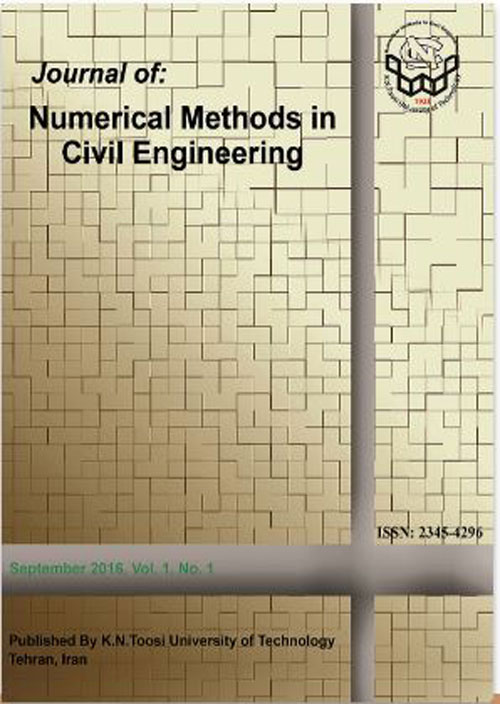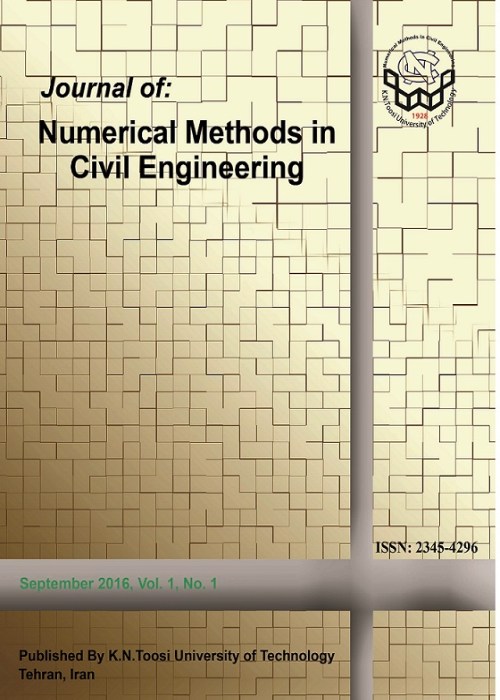فهرست مطالب

Journal of Numerical Methods in Civil Engineering
Volume:6 Issue: 4, Jun 2022
- تاریخ انتشار: 1401/03/03
- تعداد عناوین: 8
-
-
Pages 1-15
The investigation of damage to buildings in terms of non-structural walls collapse in the past earthquakes have caused researchers to study the seismic behavior of walls more extensively. Furthermore, seismic design codes have considered using wall posts to prevent wall damage, however, not many studies were done on seismic behavior change in structures due to the addition of wall posts. Therefore, in this study, a two-story structure was simulated in laboratory conditions on a shaking table with a scale of 1:3. This structure was subjected to Kobe scaled ground motion in two cases including with and without the wall and wall post on the second floor. According to the experimental results, the maximum first and second floors҆ displacement and the first-floor acceleration of the structure with wall and wall post compared to the structure without wall and wall post showed a decrease by 6.52, 10.75, and 60.23%, respectively. Comparison of experimental and numerical results showed a difference of 2-10%. Moreover, 10 two- and three-story structures with different wall arrangements in height were numerically modeled and studied by time-history dynamic analysis under 7 simulated records. The results showed that by adding a wall post to the wall to restrain it, and ignoring the effects of wall stiffness in design techniques, can cause a significant error in the seismic design procedure.
Keywords: combined structure, non-structural components, wall post, shaking table, Primary-secondary structures interaction -
Pages 16-28
The applications of time series modeling and statistical similarity methods to structural health monitoring (SHM) provide promising and capable approaches to structural damage detection. The main aim of this article is to propose an efficient univariate similarity method named as Kullback similarity (KS) for identifying the location of damage and estimating the level of damage severity. An improved feature extraction technique based on autoregressive (AR) model is presented to extract independent residuals of the AR model as damage-sensitive features. This technique emphasizes to choose a sufficient order such that the model residuals be independent. The proposed univariate similarity approach is a new application of the well-known KS method that attempts to measure a difference between two randomly distributed variables. The major contribution of the proposed KS method is that it only requires one measurement of undamaged and damaged conditions to compute the similarity between them. For the process of damage localization, the sensor location associated with the largest KS quantity is identified as the damaged area. In the damage level estimation, it is necessary to compare at least two different damaged conditions and find the maximum KS value in these conditions as the highest level of damage severity. The performance and capability of the improved and proposed methods is successfully verified by an experimental laboratory frame belonging to the Los Alamos National Laboratory. Results show that the methods are powerful and reliable tools for identifying the location of damage and estimating the level of damage severity.
Keywords: Structural damage detection, damage localization, damage level estimation, autoregressive model, independent residuals, Kullback similarity -
Pages 29-37
In the seismic risk assessment of structures, two main random variables are involved, namely the vulnerability of the structure and the seismic action. The aim of the study presented here is to analyze the seismic behavior of the jacket-type offshore platforms as an expensive and vital structure. Furthermore, the influence of the incidence angle of the seismic action is also investigated by using twelve ground motions, rotating the direction of both orthogonal components by 22.5° (from 0° to 180°). Three damage states have been used in result interpretation. The variability of structural response to the direction of seismic input becomes larger as the level of inelastic behavior increases. In the present study, the critical directions were determined and the vulnerability of jacket type offshore structure was examined by fragility curve based on methodology suggested by Pacific Earthquake Engineering Research Center (PEER) for three damage limit states by both multicomponent incremental dynamic analysis (MIDA) and directional multicomponent incremental dynamic analysis (DMIDA). Finally, it is found that structural behavior in the collapse zone is sensitive to directional uncertainty can change the results by up to 10%.
Keywords: Seismic behaviour, Jacket-type offshore platform, Directional uncertainty, 3D modelling, Soil-pile-structure interaction -
Pages 38-46
In this paper, the dynamic responses of cracked beams under different moving forces, including moving load, moving mass, moving oscillator, and four-degrees-of-freedom moving system, are investigated. Structural elements such as beams are designed to withstand the predicted loads, but unfortunately, they are always exposed to unpredictable damage such as cracks. Several factors may cause these damages, and the important thing is that their presence can affect the dynamic behavior of the beam or even endanger its reliability and durability in some cases. Therefore, this study considers an Euler-Bernoulli single-span beam with simple supports and a crack. First, with the help of the function expansion method and by employing MATLAB software, the dynamic time history responses of the beam at its midpoint under the influence of each type of moving force are extracted. Then, the changes in maximum displacement responses due to various parameters such as velocity, load magnitude, crack depth, and crack location are plotted in different spectra and compared with each other. The results show that the beam will have close results under all types of moving force (moving load, moving oscillator, and moving system) except moving mass. Obviously, this difference is due to the effect of inertia on the moving mass.
Keywords: Euler-Bernoulli beam, Cracked beam, Moving load, Moving mass, Moving oscillator, Moving system, Response spectra -
Pages 47-58
This research suggests a novel method to use steel cables as a structural bracing system. The Moment Resisting Frame (MRF) works in tandem with the cable bracings when this method is used. The suggested bracing model can address the fundamental problem of current cable bracing methods, namely the lack of flexibility while keeping costs to a minimum. This approach requires no additional equipment, and despite the minor alterations to the structure, it uses MRF’s full flexibility by delaying the brace action while minimizing substantial and undesirable displacements. This bracing method combines the major advantages of MRFs with cable bracing. For 1, 3, and 6-story 2D frames, the performance of frames that use the provided bracing mechanism was investigated. The numerical results of the dynamic analyses done for this study reveal that the proposed bracing approach was successful for the seismic protection of the structure. The relative displacement of the floors is substantially decreased when using the suggested method, yet the designer may make the structure’s behavior predictable by adjusting the model specifications. The fluctuations in axial forces and moments transferred to the beams and columns, as well as the forces applied to the structural cables, and most importantly, the stresses subjected to the central plate, are investigated in this study. Another advantage of this research is that it demonstrates how this method may lead all cables to share a considerable portion of the load-bearing capacity.
Keywords: Cable bracing, Steel plate, Plate stress, Retrofitting of structures, Rehabilitation systems -
Pages 59-66
This study numerically predicts the failure scenario of a cracked concrete gravity dam through a push-over nonlinear analysis. The mixed-mode Linear Elastic Fracture Mechanics (LEFM) was employed using the extended finite element method (XFEM). The dam base was considered to be fully fixed without any foundation effects. The hydrostatic pressure on the dam's upstream face was increased incrementally. The failure scenario type of the concrete gravity dams with an initial crack at an arbitrary level exhibited a ductile manner. A mixed-mode crack path with a positive mode II was observed in all initial crack levels. Based on the results, it can be claimed that provided water intrusion prevented, "cracked" concrete gravity dams may not be at noticeable risk of failure due to flood inflow.
Keywords: Concrete gravity dam, Linear Elastic Fracture MechanicPush-over analysis, Failure scenario, Extended finite element -
Pages 67-77
A potential multi -hazard scenario for buildings is the sequential occurrence of fire and earthquake. This scenario is possible if an initial seismic event triggers fire and a subsequent aftershock occurs. To study the post -fire seismic performance, a numerical study is presented on a two -story self-centering steel plate shear wall. This system consists of post -tensioned elements such as strands and bars to reduce the residual drift in the structure and energy dissipator devices to dissipate the seismic input energy. This paper assesses the seismic behavior of self-centering steel plate shear walls after fire loading and proposes modifications to their structural details so that fire robustness can be achieved in addition to seismic resilience. This system is simulated using the finite element method (FEM) and is verified based on available experimental results. Then, fire loading is applied, and results are compared for protected and unprotected models. Results showed that protecting steel members with fire - resistant coating can significantly improve the post -fire seismic performance of the system. The protected models reveal higher lateral strength relative to unprotected models with an increase in temperature. The maximum lateral strength of the self-centering steel plate shear wall model with shielded steel web panels, the model with shielded strands, and the model with both shielded strands and steel web panels are respectively 56%, 21%, and 61% greater than the model without fire -resistant coating at 700 °C.
Keywords: Self-centeringconnections, selfcentering steel plateshear wall, finite element, post-fire earthquake, energy dissipation -
Pages 78-97
Damage sustained by electrical transformers in past strong earthquakes led to irrecoverable and severe economic losses. The seismic performance evaluation is associated with the loss of proper functioning of transformers. This study deals with modeling existing isolated electrical transformer structures to evaluate the effects of variables that may affect the seismic performance and dynamic characteristics. The results probabilistically determine the seismic performance acceptability of study isolated electrical transformer structures based on the impact of key structural response parameters on the seismic performance of the transformer. Analyses of systems for a wide range of parameters are performed. The effects of horizontal and vertical near -fault pulse -like ground motions, the displacement capacity of the seismic isolation system, limit states of electrical bushings , and details of the isolation system design are considered. Also, the probability of failure of the transformer under the near -fault excitations with pulse -like characteristics is investigated. The results of the research showed that the three - dimensional seismic isolation system has a significant effect on improving the seismic performance of the system for a large number of parameters and can be further effective compared with horizontal-only seismic isolation , offering the lowest probabilities of failure for all cases of transformer and isolation system parameters.
Keywords: Electrical transformer, Three-dimensionalisolation, Failure performanceevaluation, near-fault pulse-likeground motions, fragility curves


